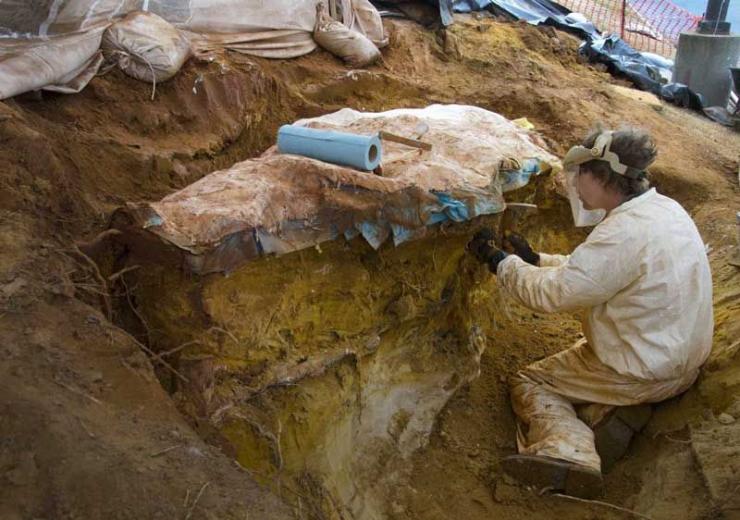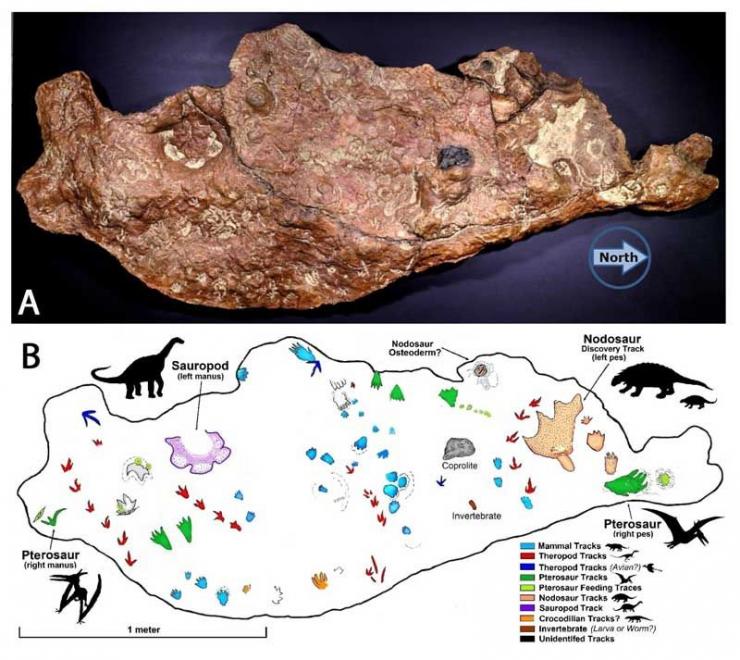 The slab of sandstone, the size of a dining room table, contains 70 mammal and dinosaur tracks from eight species, including squirrel-sized mammals and tank-sized dinosaurs. The fossil footprints, likely made within days of each other, provide a rare glimpse of the mammals and dinosaurs interacting, which make this find extraordinary.
Dr. Stephen Godfrey, Calvert Marine Museum’s Curator of Paleontology, has co-authored a new paper published in Scientific Reports on January 31, 2018 entitled: “A diverse mammal-dominated, footprint assemblage from wetland deposits in the Lower Cretaceous of Maryland.”
Dr. Godfrey authored the paper with Ray and Sheila Stanford; Martin Lockley, paleontologist at the University of Colorado; and Compton Tucker, Earth Scientist at NASA Goddard Space Flight Center. Below are excerpts taken from the NASA’s press release, published January 31, 2018:
The slab of sandstone, the size of a dining room table, contains 70 mammal and dinosaur tracks from eight species, including squirrel-sized mammals and tank-sized dinosaurs. The fossil footprints, likely made within days of each other, provide a rare glimpse of the mammals and dinosaurs interacting, which make this find extraordinary.
Dr. Stephen Godfrey, Calvert Marine Museum’s Curator of Paleontology, has co-authored a new paper published in Scientific Reports on January 31, 2018 entitled: “A diverse mammal-dominated, footprint assemblage from wetland deposits in the Lower Cretaceous of Maryland.”
Dr. Godfrey authored the paper with Ray and Sheila Stanford; Martin Lockley, paleontologist at the University of Colorado; and Compton Tucker, Earth Scientist at NASA Goddard Space Flight Center. Below are excerpts taken from the NASA’s press release, published January 31, 2018:
As the scientists continue to study the tracks and compare them to others found in the area and around the world, they will continue to discover more about prehistoric life that existed here."The concentration of mammal tracks on this site is orders of magnitude higher than any other site in the world,” said Martin Lockley, paleontologist with the University of Colorado, Denver, a co-author on the new paper. “I don't think I've ever seen a slab this size, which is a couple of square meters, where you have over 70 footprints of so many different types. This is the mother lode of Cretaceous mammal tracks.”
The first track Stanford found was of a nodosaur – "think of them as a four-footed tank," Stanford said. Subsequent examination revealed prints of a baby nodosaur beside and within the track of the adult nodosaur, likely indicating that they were traveling together. The other dinosaur tracks include: a sauropod, or long-necked plant-eater; small theropods, crow-sized carnivorous dinosaurs closely related to Velociraptor and Tyrannosaurus rex; and pterosaurs, a group of flying reptiles that included pterodactyls.
“There was something about this surface, this substrate, that was very attractive,” Lockley said. “It looks like it was very organic-rich. Fortunately for us, the slab was suddenly covered in sediment, which preserved the tracks.”
The dinosaur tracks are impressive, but it is the collection of mammal tracks that make the slab significant. At least 26 mammal tracks have been identified on the slab since the 2012 discovery – significantly more than have been discovered anywhere else in the world. Furthermore, the slab also contains the largest mammal track ever discovered from the Cretaceous. It is about the size of modern raccoon's prints.

Lockley and Stanford said most of these ancient footprints belong to what we would consider small mammals – animals the size of squirrels or prairie dogs. Most Cretaceous mammals discovered to date have been the size of rodents, their size usually determined only from their teeth. “When you have only teeth, you have no idea what the animals looked like or how they behaved,” Lockley said.
Lockley and Stanford believe the wide diversity and number of tracks show many of the animals were in the area, actively feeding at the same time. Perhaps the mammals were feeding on worms and grubs, the small carnivorous dinosaurs were after the mammals, and the pterosaurs could have been hunting both the mammals and the small dinosaurs.
The parallel trackway patterns made by four crow-sized carnivorous dinosaurs suggests they were hunting or foraging as a group. The team gave the new formal scientific name of Sederipes goddardensis, meaning “sitting traces from Goddard Space Flight Center,” to this unusual configuration of tracks.
“We do not see overlapping tracks” said Compton Tucker, a Goddard Earth scientist who helped with the excavation, coordinated bringing in multiple scientists to study the tracks, and has worked to create a display of the cast in Goddard's Earth science building. “Overlapping tracks would occur if multiple tracks were made over a longer period while the sand was wet." Tucker added, “people ask me why were all these tracks in Maryland?” I reply, “Maryland has always been a desirable place to live.” The authors have also noted that the Cretaceous environment was “swampy” 100-120 million years ago. This makes for good jokes today, but also points to a serious side of geological research into long-term climatic and environmental change.
“This could be the key to understanding some of the smaller finds from the area, so it brings everything together,” Lockley said. "This is the Cretaceous equivalent of the Rosetta stone."